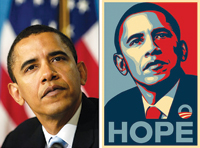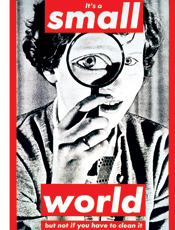
Sonya Katyal is the Joseph M. McLaughlin Professor of Law and associate dean for research at Fordham Law. Her book (co-authored with Eduardo M. Penalver) is Property Outlaws (Yale University Press, 2010).
Photo by Chris Taggart
Law and art have always had a curious relationship. While artists love to push legal boundaries, some contemporary artists, particularly artists who appropriate from works by other artists, have gotten themselves into a host of disputes involving copyright and trademark law.
Below is a list of some of the most famous cases involving the intersection of contemporary art and intellectual property.
1. Wojnarowicz v. American Family Association,
745 F. Supp. 130 (S.D.N.Y. 1990)
In this action, David Wojnarowicz, a famous multimedia artist and gay rights activist, sued the American Family Association for violations of the New York Artists’ Authorship Rights Act. At issue was a pamphlet prepared by the AFA that displayed cropped images of Wojnarowicz’s work over the caption “Your Tax Dollars Helped Pay For These ‘Works of Art.’” He won an injunction, forcing the AFA to publish a corrective advertisement.
2. Cariou v. Prince,
714 F.3d 694 (2d Cir. 2013)
In a very recent, landmark case before the Second Circuit, Patrick Cariou, a little-known photographer, sued Richard Prince, a famous appropriation artist, when Prince used several of Cariou’s photographs in a series of collages that were sold for tens of millions of dollars. (Cariou received nothing from Prince’s massive sales). Although Cariou initially won at the district court level, the Second Circuit reversed most of the court’s findings in favor of fair use for Prince.
3. Rogers v. Koons, 960 F.2d 301 (2d Cir. 1992)
In this case, influential postwar artist Jeff Koons appropriated a photograph taken by Art Rogers of two people holding a bunch of puppies. Although Koons made a sculpture from the photo, changing the colors of the puppies (to bright blue) and altering a few other elements, the court rejected his parody defense, and it remains one of the most noteworthy cases involving modern art today.
 4. Fairey v. Associated Press,
4. Fairey v. Associated Press,
No. 09-01123 (S.D.N.Y. 2010)
In this case, Shepard Fairey, a famous street artist and brand personality, was sued by the AP for his appropriation of a photograph of Barack Obama that he used to create the iconic “HOPE” poster for Obama’s presidential campaign. The case eventually settled, but the questions raised regarding the limits of fair use continue.
5. Mattel Inc. v. Walking Mt. Prods.,
353 F.3d 792 (9th Cir. 2003)
A photographer took a series of pictures of Barbie dolls, titled “Food Chain Barbie,” which included the famous doll in a series of poses, sometimes with food, and at other times accompanied by vintage kitchen appliances. Walking Mt. used the photographs to comment on Barbie’s role in creating a culture that objectified women. Mattel was incensed and sued for trademark and copyright infringement. Mattel lost.
 6. Hoepker v. Kruger,
6. Hoepker v. Kruger,
200 F. Supp. 2d 340 (2002)
A well-known German photographer sued contemporary American artist Barbara Kruger for her use of a photograph of a woman with a magnifying glass. Kruger cropped and enlarged the image, and then superimposed three large red blocks containing words that read, “It’s a small world but not if you have to clean it.” Given that the photograph was in the public domain in the United States, Kruger won the case.
7. Morris v. Thierry Guetta,
2013 U.S. Dist. LEXIS 15556 (C.D. Cal. 2013)
In this case, Thierry Guetta, a well-known appropriation and street artist who goes by the name Mr. Brainwash, appropriated a famous photograph of Sid Vicious taken by David Morris. In that case, a district court in California found that the appropriation was not sufficiently transformative to justify the protection of fair use, and Guetta lost.
8. Plesner v. LVMH,
Court of the Hague 389526 / KG ZA 11-294, (May 4, 2011)
In this case, one of the few international cases involving appropriation art, Nadia Plesner, a Danish artist, was sued in The Hague by luxury manufacturer Louis Vuitton for her appropriation of one of its bags in a painting entitled Darfurnika (Plesner’s modern-day homage to Guernica, Picasso’s famous piece). The painting merged political and fashion icons to draw attention to the political situation in Darfur. Plesner won on freedom of artistic expression grounds.
9. Blanch v. Koons,
467 F.3d 244 (2d Cir. 2006)
Even though Koons lost his earlier case involving his depiction of the “string of puppies” from an Art Rogers postcard, he won this case on the grounds of fair use. Here, Koons appropriated a photograph of woman’s legs and sandals from a Gucci ad for one of his paintings; the court found that the photograph had been sufficiently transformative to merit fair use protection.
10. Supreme v. McSweeney,
Nos. 13 Civ. 1588 (S.D.N.Y. filed Mar. 8, 2013)
In this fascinating streetwear case, James Jebbia, owner of the famous brand Supreme (known for its appropriation of Barbara Kruger’s red box lettering style for its logo), sued another brand, Leah McSweeney’s Married to the Mob, for her use of Supreme’s logo in the creation of her own brand, Supreme Bitch, in the same style. McSweeney claims that her appropriation of the brand is meant to be a parody to poke fun at Supreme’s male-dominated streetwear culture; the case is still ongoing.


